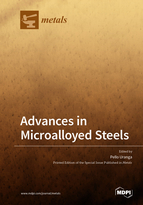Advances in Microalloyed Steels
A special issue of Metals (ISSN 2075-4701).
Deadline for manuscript submissions: closed (30 September 2018) | Viewed by 64593
Special Issue Editor
Interests: thermomechanical processing; microstructural evolution modeling; microalloying; microstructure–property relationship
Special Issues, Collections and Topics in MDPI journals
Special Issue Information
Dear Colleagues,
In response to the demanding requirements of different sectors, such as construction, transportation, energy, manufacturing, and mining, new generations of microalloyed steels are being developed and brought to market. The addition of microalloying elements, such as Niobium, Vanadium, Titanium, Boron and/or Molybdenum have become a key tool in the steel industry to reach economically-viable grades with increasingly higher mechanical strengths, toughness properties, good formability and weldable products.
The challenges that microalloying steel production face can be successfully solved with a deeper understanding of the effects that these microalloying additions and combinations of them have during the different steps of the steelmaking process. Their influence in softening mechanisms, such as recrystallization and grain growth during hot working, precipitation kinetics, phase transformation during cooling, and the relationship between the final microstructure and mechanical properties are just some examples of subjects of interest for research in industry and academia.
The availability of advanced characterization techniques together with innovative modelling strategies provides new tools to understand these open issues and achieve valid answers for the development of new microalloyed grades and the optimization of the processing routes.
For this Special Issue on "Advances in Microalloyed Steels", I would like to invite researchers from steel industry and academia to submit their latest developments and achievements in this field.
Assoc. Prof. Pello Uranga
Guest Editor
Manuscript Submission Information
Manuscripts should be submitted online at www.mdpi.com by registering and logging in to this website. Once you are registered, click here to go to the submission form. Manuscripts can be submitted until the deadline. All submissions that pass pre-check are peer-reviewed. Accepted papers will be published continuously in the journal (as soon as accepted) and will be listed together on the special issue website. Research articles, review articles as well as short communications are invited. For planned papers, a title and short abstract (about 100 words) can be sent to the Editorial Office for announcement on this website.
Submitted manuscripts should not have been published previously, nor be under consideration for publication elsewhere (except conference proceedings papers). All manuscripts are thoroughly refereed through a single-blind peer-review process. A guide for authors and other relevant information for submission of manuscripts is available on the Instructions for Authors page. Metals is an international peer-reviewed open access monthly journal published by MDPI.
Please visit the Instructions for Authors page before submitting a manuscript. The Article Processing Charge (APC) for publication in this open access journal is 2600 CHF (Swiss Francs). Submitted papers should be well formatted and use good English. Authors may use MDPI's English editing service prior to publication or during author revisions.
Keywords
- Niobium
- Vanadium
- Titanium
- Boron
- Molybdenum
- Thermomechanical Processing
- Phase Transformations
- Microstructure
- Mechanical Properties
- Modelling






